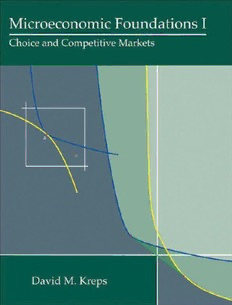
Microeconomic Foundations I: Choice and Competitive Markets PDF
Preview Microeconomic Foundations I: Choice and Competitive Markets
Microeconomic Foundations I Microeconomic Foundations I Choice and Competitive Markets David M. Kreps PRINCETON UNIVERSITY PRESS | PRINCETON AND OXFORD Copyright © 2013 by Princeton University Press Published by Princeton University Press, 41 William Street, Princeton, New Jersey 08540 In the United Kingdom: Princeton University Press, 6 Oxford Street, Woodstock, Oxfordshire OX20 1TW pup.princeton.edu All rights reserved Library of Congress Cataloging-in-Publication Data Kreps, David M. Microeconomic foundations / David M. Kreps p. cm. Includes bibliographical references and index. ISBN 978-0-691-15583-8 (hbk. : alk. paper) 1. Microeconomics. I. Title. HB172.K744 2013 338.5–dc23 2012011926 British Library Cataloging-in-Publication Data is available This book has been composed in Helvetica, Palatino, and Computer Modern typefaces. The publisher would like to acknowledge the author of this volume for providing the camera-ready copy from which this book was published. Printed on acid-free paper ∞ Printed in the United States of America 1 3 5 7 9 10 8 6 4 2 To Kenneth J. Arrow Contents Preface Chapter One. Choice, Preference, and Utility 1.1. Consumer Choice: The Basics 1.2. Proving Most of Proposition 1.2, and More 1.3. The No-Better-Than Sets and Utility Representations 1.4. Strict Preference and Indifference 1.5. Infinite Sets and Utility Representations 1.6. Choice from Infinite Sets 1.7. Equivalent Utility Representations 1.8. Commentary Bibliographic Notes Problems Chapter Two. Structural Properties of Preferences and Utility Functions 2.1. Monotonicity 2.2. Convexity 2.3. Continuity 2.4. Indifference Curve Diagrams 2.5. Weak and Additive Separability 2.6. Quasi-linearity 2.7. Homotheticity Bibliographic Notes Problems Chapter Three. Basics of Consumer Demand 3.1. The Consumer’s Problem 3.2. Basic Facts about the CP 3.3. The Marshallian Demand Correspondence and Indirect Utility Function 3.4. Solving the CP with Calculus Bibliographic Notes Problems Chapter Four. Revealed Preference and Afriat’s Theorem 4.1. An Example and Basic Ideas 4.2. GARP and Afriat’s Theorem 4.3. Comparative Statics and the Own-Price Effect Bibliographic Notes Problems Chapter Five. Choice under Uncertainty 5.1. Two Models and Three Representations 5.2. The Mixture-Space Theorem 5.3. States of Nature and Subjective Expected Utility 5.4. Subjective and Objective Probability and the Harsanyi Doctrine 5.5. Empirical and Theoretical Critiques Bibliographic Notes Problems Chapter Six. Utility for Money 6.1. Properties of Utility Functions for Money 6.2. Induced Preferences for Income 6.3. Demand for Insurance and Risky Assets Bibliographic Notes Problems Chapter Seven. Dynamic Choice 7.1. The Standard Strategic Approach 7.2. Dynamic Programming 7.3. Testable Restrictions of the Standard Model 7.4. Three Alternatives to the Standard Model Bibliographic Notes Problems Chapter Eight. Social Choice and Efficiency 8.1. Arrow’s Theorem 8.2. What Do We Give Up? 8.3. Efficiency 8.4. Identifying the Pareto Frontier: Utility Imputations and Bergsonian Social Utility Functionals 8.5. Syndicate Theory and Efficient Risk Sharing: Applying Proposition 8.10 8.6. Efficiency? Bibliographic Notes Problems Chapter Nine. Competitive and Profit-Maximizing Firms 9.1. The Production-Possibility Set 9.2. Profit Maximization 9.3. Basics of the Firm’s Profit-Maximization Problem 9.4. Afriat’s Theorem for Firms 9.5. From Profit Functions to Production-Possibility Sets 9.6. How Many Production-Possibility Sets Give the Same Profit Function? 9.7. What Is Going On Here, Mathematically? 9.8. Differentiability of the Profit Function 9.9. Cost Minimization and Input-Requirement Sets 9.10. Why Do We Care? Bibliographic Notes Problems Chapter Ten. The Expenditure-Minimization Problem 10.1. Defining the EMP 10.2. Basic Analysis of the EMP 10.3. Hicksian Demand and the Expenditure Function 10.4. Properties of the Expenditure Function 10.5. How Many Continuous Utility Functions Give the Same Expenditure Function? 10.6. Recovering Continuous Utility Functions from Expenditure Functions 10.7. Is an Alleged Expenditure Function Really an Expenditure Function? 10.8. Connecting the CP and the EMP Bibliographic Notes Problems Chapter Eleven. Classic Demand Theory 11.1. Roy’s Identity and the Slutsky Equation 11.2. Differentiability of Indirect Utility 11.3. Duality of Utility and Indirect Utility 11.4. Differentiability of Marshallian Demand 11.5. Integrability 11.6. Complements and Substitutes 11.7. Integrability and Revealed Preference Bibliographic Notes Problems Chapter Twelve. Producer and Consumer Surplus 12.1. Producer Surplus 12.2. Consumer Surplus Bibliographic Notes Problems Chapter Thirteen. Aggregating Firms and Consumers 13.1. Aggregating Firms 13.2. Aggregating Consumers 13.3. Convexification through Aggregation Bibliographic Notes Problems Chapter Fourteen. General Equilibrium 14.1. Definitions 14.2. Basic Properties of Walrasian Equilibrium 14.3. The Edgeworth Box 14.4. Existence of Walrasian Equilibria 14.5. The Set of Equilibria for a Fixed Economy
